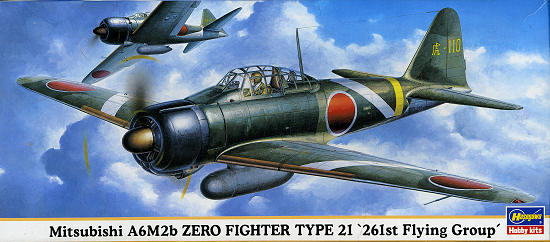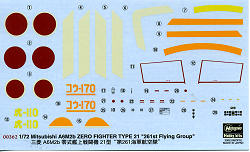
Hasegawa 1/72 A6M2b '261st Flying Group'
| KIT #: | 00362 |
| PRICE: | At the time, about $18.00 |
| DECALS: | Three options |
| REVIEWER: | Scott Van Aken |
| NOTES: | 2002 limited release |

| HISTORY |
| THE KIT |
 Probably
because Hasegawa wore out the molds on the old Zero kit, they decided a few
decades back, that perhaps it would be a good idea to go the 'multiple variants'
route and do the entire series of A6Ms. Thanks to much of the airframe being the
same, this was an easy to do endeavor. Basically, just the cowling and the wings
are changed from version to version. As the Zero is probably the most sold model
kit in the world, Hasegawa has done very well in this area and special boxings
seem to sell out with great regularity.
Probably
because Hasegawa wore out the molds on the old Zero kit, they decided a few
decades back, that perhaps it would be a good idea to go the 'multiple variants'
route and do the entire series of A6Ms. Thanks to much of the airframe being the
same, this was an easy to do endeavor. Basically, just the cowling and the wings
are changed from version to version. As the Zero is probably the most sold model
kit in the world, Hasegawa has done very well in this area and special boxings
seem to sell out with great regularity.
This particular boxing is for a very colorful plane from the 261st Flying Group. Though the unit, formed in mid 1943, primarily flew the A6M5, there were a number of earlier versions assigned, as much to replace losses as anything. The unit fought at Pelileu and later in the Borneo theater, guarding the refineries at Palembang.
Typical of Hasegawa, the cockpit is a bit sparse, using a decal for the instrument panel. Fortunately, there are aftermarket sets to help. The one piece canopy is very clear. Inserts are used for the lower cowling and upper forward fuselage. The two piece engine is very nicely done and looks the part once in the cowling. The only optional bit is the belly tank, something not always carried on defensive missions, though it would be appropriate for longer patrols.
 Instructions
are Hasegawa's usual fare with Gunze paint references. The two planes on the
decal sheet are the box art plane from the 261st Flying Group in what
appears to be a two tone upper green with grey undersides. I think this two
shaded appearance is little more than faded paint and patches. I've seen the
original photo from which this scheme comes and you can tell that sections are
darker than others. It is quite possible that this is due to piecing together
bits from other planes and repainting badly worn sections. The other is also in
green and grey and from the Kohnoike Flying Group, a training unit based in
Japan and often used for air defense. Hence the fuselage banding in trainer
orange. Decals are well printed and of the 'old' style with white that is
off-white. One would probably be well to paint the banding.
Instructions
are Hasegawa's usual fare with Gunze paint references. The two planes on the
decal sheet are the box art plane from the 261st Flying Group in what
appears to be a two tone upper green with grey undersides. I think this two
shaded appearance is little more than faded paint and patches. I've seen the
original photo from which this scheme comes and you can tell that sections are
darker than others. It is quite possible that this is due to piecing together
bits from other planes and repainting badly worn sections. The other is also in
green and grey and from the Kohnoike Flying Group, a training unit based in
Japan and often used for air defense. Hence the fuselage banding in trainer
orange. Decals are well printed and of the 'old' style with white that is
off-white. One would probably be well to paint the banding.
| CONCLUSIONS |
I doubt if there are many out there who have not built a Hasegawa Zero in any scale. These are basically trouble free builds and can quickly be made into very nice models. Enough so that many of us have a bit of a collection of them! They don't seem to stay on store shelves for long and for that reason should be snagged when one finds them.
| REFERENCES |
Japanese Naval Aces and Fighter Units, Naval Institute Press, 1989
January 2009
If you would like your product reviewed fairly and quickly, please contact me or see other details in the Note to Contributors.